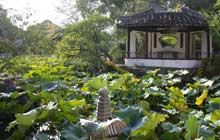
 The Chinese consider gardens a serious art form and as with painting, sculpture and poetry aim to attain in their design the balance, harmony, proportion and variety that are considered essential to life. In fact there is a saying which goes, 'the garden is an artistic recreation of nature; a landscape painting in three dimensions" . Through a combination of such natural elements as rock, water, trees and flowers and such artificial elements as architecture, painting and poetry, the designer sought to attain an effect which adhered to the Daoist principles of balance and harmony, man and nature.
The Chinese consider gardens a serious art form and as with painting, sculpture and poetry aim to attain in their design the balance, harmony, proportion and variety that are considered essential to life. In fact there is a saying which goes, 'the garden is an artistic recreation of nature; a landscape painting in three dimensions" . Through a combination of such natural elements as rock, water, trees and flowers and such artificial elements as architecture, painting and poetry, the designer sought to attain an effect which adhered to the Daoist principles of balance and harmony, man and nature.
The Chinese garden is divided into three categories: the imperial garden, the private garden and the natural scenic site. The earliest imperial garden dates back to the late Shang dynasty (c. 1600-1027 BC) with the construction of an imperial hunting ground, followed by the Shanglin garden built by the Emperor Qinshihuangdi in his capital at Xianyang. The latter was completed by the Han Emperor Wudi (r. 140-87 BC) and is thought to have been the basis upon which the Summer Palace was designed. The first private garden, known also as a literati garden, appeared during the Northern and Southern dynasties (420-589). Natural scenic sites, which were large scale gardens built against the backdrop of naturally existing mountains, valleys, lakes, etc., were used as the pleasure grounds of the imperial house and nobility.
Of the three types of Chinese gardens, it is the private garden which is of most interest when visiting the 'Garden City' of Suzhou. They are the most intimate of the group and were created as a place of retreat for the gentleman-scholar to escape the chaos of the city. It was during the Tang dynasty (618-907) that the literati garden reached its height, a treatise on garden design being written in 634 by the painter-gardener Ji Cheng. One of the key elements of this treatise was the necessity for the garden to "look natural, though man-made". Also stressed was the harmonious combination of opposites, that is of the small and large, of the revealing and concealing, of the real and unreal, and of the vertical and horizontal.
A common feature of Chinese garden architecture is the waterside pavilion – a derivation of an ancient wooden house supported on stilts. It later became the fashion to build waterside pavilions upon the lake or pond of a garden so that half the structure was built on land, while the other half was raised on stilts above a body of water. So as to allow viewing of the garden from all sides of the building, decorative windows were placed along the periphery of the wall. Such a waterside pavilion can be seen in the Humble Administrator's Garden .
Another key element of Chinese gardens is their covered corridors, built to allow the owners to enjoy the garden in the rain and snow. These covered walkways fall into two categories, those which connect buildings and those which are built by the shore of a small pond or lake. As with waterside pavilions, corridors often have windows or "scenic openings", which act as picture frames directing the eye to particular views of the garden. Such scenic openings were designed simply as circles, squares or ovals or in more imaginative shapes like those of a lotus petal, garland or bay leaf.
Often the most exquisite elements of a Chinese garden can be found in its details. Such is the case with the footpaths, imaginatively patterned with coloured pebbles into a variety of designs along the ground. A common motif is that of the square within a circle, signifying the ancient belief that the "heaven is round and the earth square". Good luck omens may also often be found. Whilst the bat and crane symbolize good fortune and longevity, the fishing net portends affluence. There are, in addition, often depictions of scenes from well-known traditional paintings and legends.
The Garden of the Master of the Nets is one of the smallest gardens in Suzhou, but is also consider one of its finest. Constructed in the twelfth century and then, after a period of abandonment, restored during the eighteenth century, it was the residence of a retired official. The eastern part of the grounds served as the residential area, the central section was the main garden and the western portion the inner garden. The Humble Administrator's Garden was so-named after a Jin dynasty (1115-1234) poem which read, 'Watering the garden and selling vegetables constitute a humble administrator's business.' Originally the home of the Tang Poet, Lu Guimou, the garden took on its present form during the Ming dynasty and is perhaps one of the most representative of Ming dynasty garden designs.